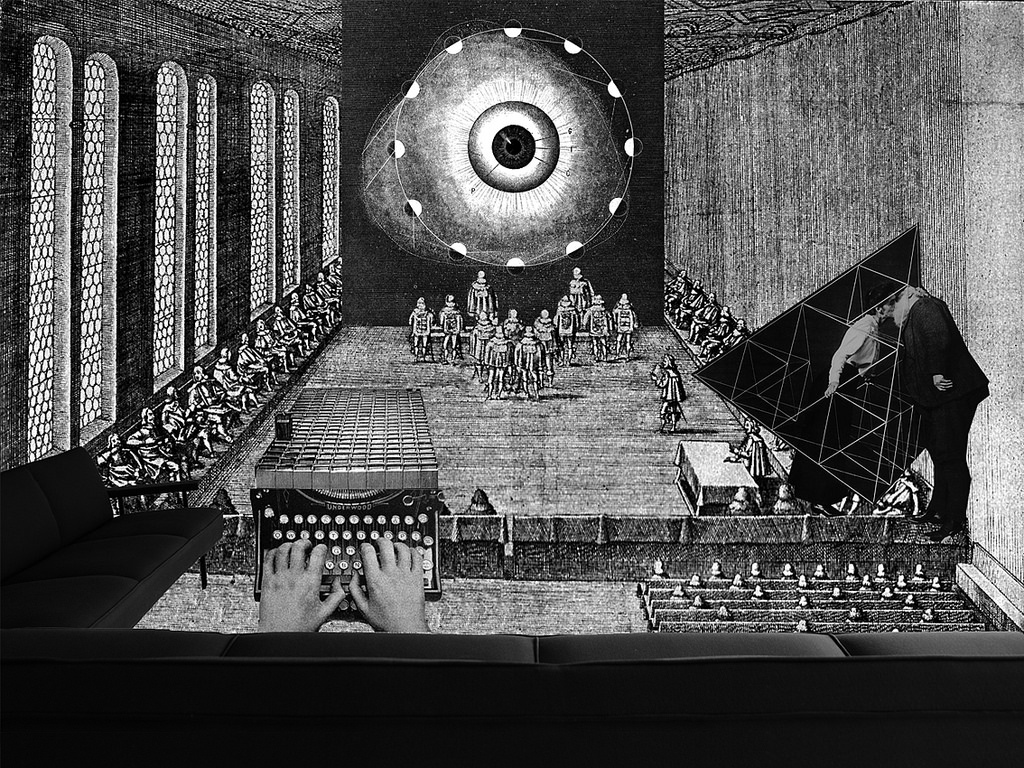Continent. 5(2): The Technosphere, Now (2016)
Filed under journal | Tags: · agency, anthropocene, biopshere, body, complexity, earth, ecology, food, human, infrastructure, media, nature, production, systems theory, technology, technosphere, waste, water

“The “technosphere” is geologist Peter Haff’s term for the planetary-scale networks of transport, information, energy and media operating at a scale and functional efficacy that we can now compare with geological and climatic forces—the soils and rocks of the lithosphere, the waters of the hydrosphere or the winds of the atmosphere. Its emergence as a thematic is driven by the same witnessing of intertwining natural environments, vast socio-technical forces, and increasingly diverse technological species and spaces that has precipitated discussions of the Anthropocene.
[…] The Technosphere project at the HKW in Berlin (2015-18) began with an initial gathering in Autumn 2015. The first occasion for the ongoing collaboration between continent. and HKW was the latter’s hosting of The Technosphere, Now event in October, 2015 in Berlin. Editors from continent. came from various corners of the globe, invited to immerse themselves into and extrapolate from the talks, discussions, presentations and demonstrations held there. Interview-discussions held with the likewise international set of researchers, theorists, artists and scientists at this event precipitated an online special issue of continent. for April 2016, featuring articles titled by the names of our interviewees.”
Features interviews with Arno Rosemarin, Birgit Schneider, Bronislaw Szerszynski, Donald MacKenzie, Erich Hörl, Jennifer Gabrys, Lino Camprubí, Lucy A. Suchman, Mark Hansen, Masahiro Terada, Mushon Zer-Aviv, Oliver Sann, Peter K. Haff, S. Løchlann Jain, and Scott Gabriel Knowles.
Edited by Nina Jäger, Paul Boshears, Bernhard Garnicnig, Jamie Allen, Lital Khaikin, Katrin Klingan, Anna Sophie Luhn, Christoph Rosol, and Nick Hood
Publisher continent., Apr 2016
Creative Commons Attribution 3.0 License
ISSN 2159-9920
Alfred Gell: Art and Agency: An Anthropological Theory (1998)
Filed under book | Tags: · aesthetics, agency, anthropology, art, art theory, causality, image, representation, style, tattoo

“Alfred Gell puts forward an anthropological theory of visual art seen as a form of instrumental action: the making of things as a means of influencing the thoughts and actions of others. He argues that existing anthropological and aesthetic theories take an overwhelmingly passive point of view, and questions the criteria that accord art status only to a certain class of objects and not to others. The anthropology of art is here reformulated as the anthropology of a category of action: Gell shows how art objects embody complex intentionalities and mediate social agency. He explores the psychology of patterns and perceptions, art and personhood, the control of knowledge, and the interpretation of meaning, drawing upon a diversity of artistic traditions-European, Indian, Polynesian, Melanesian, and Australian.”
With a Foreword by Nicholas Thomas
Publisher Clarendon Press, Oxford, 1998
ISBN 0198280149, 9780198280149
272 pages
via mrcds
Reviews: Michèle Coquet (L’Homme, 2001, FR), Kate Sharpe (European Journal of Archaeology, 2004), Jan Willem Noldus (Histara, 2009, FR), Gilles Bastin (Le Monde, 2009, FR), Christophe Domino (Le Journal des arts, 2009, FR), Pierre Charbonnier (Tina, 2010, FR), Marcel Alocco (PerformArts, 2010, FR), Agnès Giard (Libération, 2014, FR), Mylene Mizrahi (Proa, 2019, PT).
Critical analyses: Maurice Bloch (Terrain, 1999, FR), Robert Layton (Journal of the Royal Anthropological Institute, 2003), Ross Bowden (Oceania, 2004), Howard Morphy (Journal of Material Culture, 2009), Brigitte Derlon and Monique Jeudy-Ballini (Oceania, 2010).
PDF (68 MB, updated on 2020-6-4)
EPUB (4 MB, added on 2014-9-14 via Marcell)
Karen Barad: Meeting the Universe Halfway: Quantum Physics and the Entanglement of Matter and Meaning (2007)
Filed under book | Tags: · agency, agential realism, apparatus, epistemology, ethics, materialism, ontology, philosophy, physics, posthumanism, quantum mechanics, quantum physics, science

“Meeting the Universe Halfway is an ambitious book with far-reaching implications for numerous fields in the natural sciences, social sciences, and humanities. In this volume, Karen Barad, theoretical physicist and feminist theorist, elaborates her theory of agential realism. Offering an account of the world as a whole rather than as composed of separate natural and social realms, agential realism is at once a new epistemology, ontology, and ethics. The starting point for Barad’s analysis is the philosophical framework of quantum physicist Niels Bohr. Barad extends and partially revises Bohr’s philosophical views in light of current scholarship in physics, science studies, and the philosophy of science as well as feminist, poststructuralist, and other critical social theories. In the process, she significantly reworks understandings of space, time, matter, causality, agency, subjectivity, and objectivity.
In an agential realist account, the world is made of entanglements of “social” and “natural” agencies, where the distinction between the two emerges out of specific intra-actions. Intra-activity is an inexhaustible dynamism that configures and reconfigures relations of space-time-matter. In explaining intra-activity, Barad reveals questions about how nature and culture interact and change over time to be fundamentally misguided. And she reframes understanding of the nature of scientific and political practices and their “interrelationship.” Thus she pays particular attention to the responsible practice of science, and she emphasizes changes in the understanding of political practices, critically reworking Judith Butler’s influential theory of performativity. Finally, Barad uses agential realism to produce a new interpretation of quantum physics, demonstrating that agential realism is more than a means of reflecting on science; it can be used to actually do science.”
Publisher Duke University Press, 2007
ISBN 082238812X, 9780822388128
xiii+524 pages
Reviews: S.S. Schweber (Isis, 2008), Sherryl Vint (Science Fiction Studies, 2008), Peta Hinton (Australian Feminist Studies, 2008), Lisa M. Dolling (Hypatia, 2009), Vita Peacock (Opticon1826, 2010), Beatriz Revelles Benavente (Graduate Journal of Social Science, 2010), Trevor Pinch (Social Studies of Science, 2011), Haris Durrani (2015).
Commentaries: Levi R. Bryant, Steven Craig Hickman.
PDF, PDF (updated on 2018-11-4)
Comments (3)
